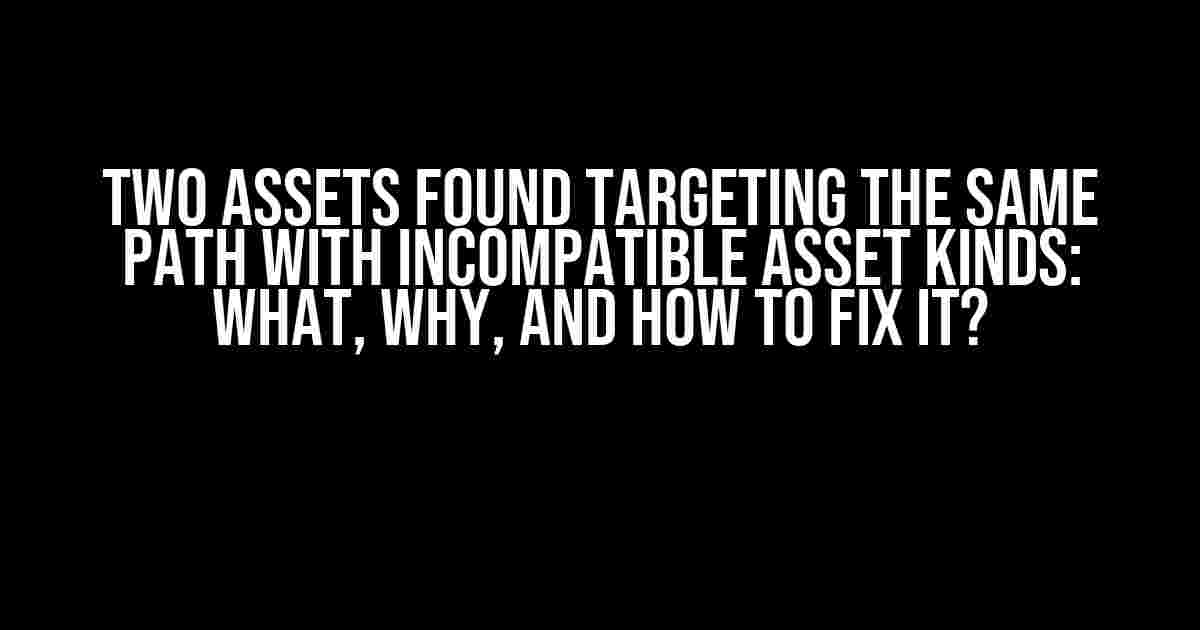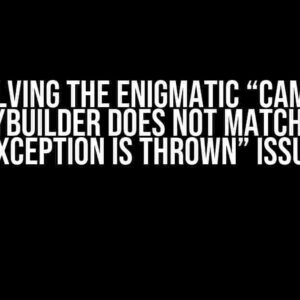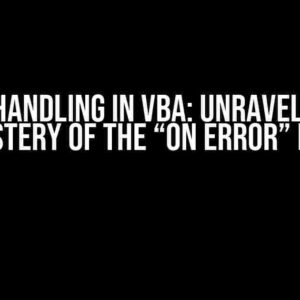If you’re an avid developer, you’ve probably stumbled upon the infamous error “Two assets found targeting the same path with incompatible asset kinds” at least once in your coding journey. It’s a frustrating issue that can bring your development process to a grinding halt, leaving you scratching your head and wondering what went wrong. Fear not, dear developer! In this article, we’ll delve into the world of asset kinds, explore the reasons behind this error, and provide you with a step-by-step guide on how to fix it once and for all.
What Are Asset Kinds?
In the context of web development, an asset kind refers to the type of file or resource that’s being served to the client’s browser. Examples of asset kinds include:
- JavaScript files (.js)
- CSS files (.css)
- Images (.jpg, .png, .gif, etc.)
- Fonts (.woff, .ttf, .otf, etc.)
Each asset kind has its unique characteristics, such as how it’s processed, cached, and rendered by the browser. When you’re building a web application, it’s essential to ensure that each asset kind is correctly configured to avoid conflicts and errors.
What Causes the “Two Assets Found Targeting the Same Path with Incompatible Asset Kinds” Error?
This error occurs when two or more assets with different kinds are trying to occupy the same URL path. This can happen due to various reasons, including:
- Incorrectly configured asset pipelines: If your asset pipeline is not set up correctly, it can lead to multiple assets being generated with the same URL path.
- : When you have multiple assets with the same name but different kinds (e.g., `script.js` and `script.css`), it can cause conflicts.
- Plugin or library issues: Sometimes, plugins or libraries can generate assets that clash with your existing assets, resulting in this error.
To fix this error, you need to identify the root cause and take corrective measures. Let’s explore some common scenarios and their solutions.
Scenario 1: Incorrectly Configured Asset Pipelines
If you’re using a build tool like Webpack or Rollup, it’s essential to configure your asset pipelines correctly. Here’s an example of a misconfigured Webpack setup:
module.exports = {
// ...
module: {
rules: [
{
test: /\.js$/,
use: 'babel-loader',
include: /node_modules/
},
{
test: /\.css$/,
use: 'css-loader',
include: /node_modules/
}
]
},
output: {
path: 'dist',
filename: 'bundle.[name].js'
}
};
In this example, both the JavaScript and CSS loaders are generating assets with the same URL path (`dist/bundle.js`). To fix this, you need to adjust the output filename to include the asset kind:
module.exports = {
// ...
module: {
rules: [
{
test: /\.js$/,
use: 'babel-loader',
include: /node_modules/
},
{
test: /\.css$/,
use: 'css-loader',
include: /node_modules/,
output: {
filename: 'styles.[name].css'
}
}
]
},
output: {
path: 'dist',
filename: 'bundle.[name].js'
}
};
By adding the `output.filename` property to the CSS loader, we’re ensuring that the generated CSS asset has a unique URL path (`dist/styles.[name].css`).
Scenario 2: Duplicated Asset Names
When you have multiple assets with the same name but different kinds, it can lead to conflicts. For instance, if you have a `script.js` and a `script.css` file, you need to rename one of them to avoid the conflict.
Here’s an example of how you can rename the CSS file to avoid the conflict:
// Before: // script.js // script.css // After: // script.js // script-styles.css
By renaming the CSS file to `script-styles.css`, we’re ensuring that both assets have unique URL paths and avoiding the conflict.
Scenario 3: Plugin or Library Issues
Sometimes, plugins or libraries can generate assets that clash with your existing assets. To fix this, you need to identify the problematic plugin or library and take corrective measures.
Here’s an example of how you can configure a plugin like `css-minimizer-webpack-plugin` to avoid conflicts with your existing CSS assets:
const CssMinimizerPlugin = require('css-minimizer-webpack-plugin');
module.exports = {
// ...
plugins: [
new CssMinimizerPlugin({
filename: '[name].min.css',
minimizerOptions: {
preset: [
'default',
{
discardComments: {
removeAll: true,
},
},
],
},
}),
],
};
In this example, we’re configuring the `css-minimizer-webpack-plugin` to generate minified CSS assets with a unique filename (`[name].min.css`). This ensures that the minified CSS assets don’t conflict with our existing CSS assets.
Best Practices to Avoid “Two Assets Found Targeting the Same Path with Incompatible Asset Kinds” Errors
To avoid this error altogether, follow these best practices:
- Use unique asset names: Ensure that each asset has a unique name, even if it’s of a different kind.
- Configure asset pipelines correctly: Take the time to configure your asset pipelines correctly, and ensure that each asset kind has a unique output filename.
- Use plugins and libraries wisely: Be cautious when using plugins and libraries, and ensure that they’re not generating assets that clash with your existing assets.
- Test and debug thoroughly: Test your application thoroughly, and debug any issues that arise. Don’t be afraid to ask for help if you’re stuck!
Conclusion
The “Two assets found targeting the same path with incompatible asset kinds” error can be frustrating, but it’s a relatively easy issue to fix once you understand the root cause. By following the best practices outlined in this article and taking the time to configure your asset pipelines correctly, you can avoid this error and ensure a smooth development process. Remember, it’s always better to be proactive than reactive, so take the time to set up your asset pipeline correctly from the get-go!
| Scenario | Solution | |
|---|---|---|
| Incorrectly configured asset pipelines | Multiple assets generated with the same URL path | Adjust output filename to include asset kind |
| Duplicated asset names | Assets with the same name but different kinds | Rename one of the assets to avoid conflict |
| Plugin or library issues | Plugins or libraries generating assets that clash with existing assets | Identify and configure the problematic plugin or library |
We hope this article has been informative and helpful in resolving the “Two assets found targeting the same path with incompatible asset kinds” error. If you have any questions or need further assistance, feel free to ask in the comments below!
Frequently Asked Questions
Get the answers to your most pressing questions about “Two assets found targeting the same path with incompatible asset kinds”.
What does the error “Two assets found targeting the same path with incompatible asset kinds” mean?
This error occurs when two or more assets, such as images or files, are trying to use the same URL or path, but they have different formats or types that can’t coexist. Think of it like trying to put a square peg into a round hole – they just don’t fit!
Why is this error a problem?
This error can cause issues with your website or application’s performance, and even lead to broken links or missing assets. It’s like having a puzzle with missing pieces – without resolving this error, your asset collection won’t be complete!
How can I fix this error?
To fix this error, you need to identify the conflicting assets and give them unique paths or URLS. You can do this by renaming one of the assets, or by using a different folder or directory for one of them. It’s like finding a new home for one of the puzzle pieces – once it’s in the right place, everything fits together smoothly!
Can I ignore this error?
While it might be tempting to ignore this error, it’s not recommended. Leaving it unresolved can lead to issues with your website or application’s performance, and even cause problems for your users. It’s like ignoring a traffic light – it might seem harmless, but it can lead to accidents!
How can I prevent this error from happening in the future?
To prevent this error from happening again, make sure to use unique and descriptive names for your assets, and organize them in a way that makes sense for your project. It’s like keeping your toolbox tidy – when everything has its own place, you’re less likely to run into problems!




